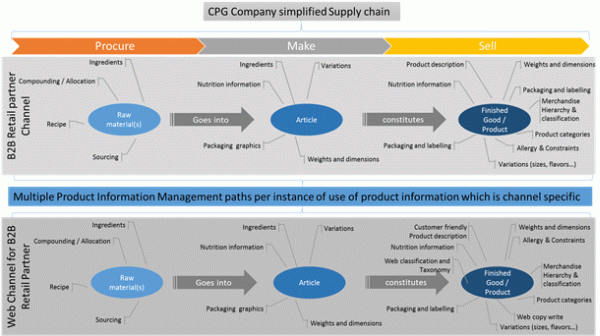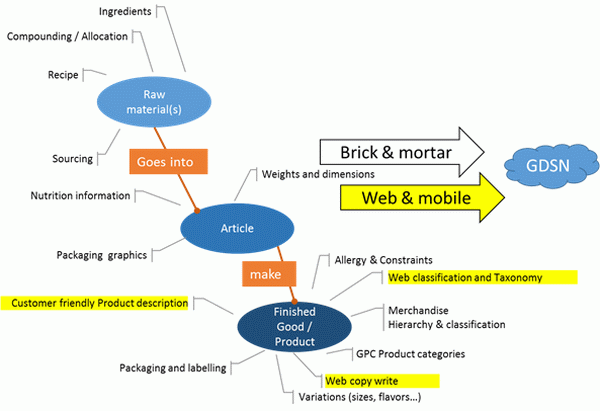Why the Product Information Supply Chain is Crucial for an Effective CPG Digital Strategy
Consumer Packaged Goods (CPG) companies pursuing digital strategies to improve or increase their top-line or bottom-line are finding that product (or raw materials) information management and the distribution / sharing of the information is crucial to the success of their strategy. This article looks at why you need a Product Information Management (PIM) system, the parallel concept of managing your product information supply chain and why understanding this concept will be crucial to the success of your digital strategy.
So what is a Product Information Supply Chain and how is it different than a PIM?
Let’s start with an acronym that we are familiar with today - PIM or Product Information Management. PIM (as defined by a recent paper from Ventana Research titled Streamlining Information for Consumer Goods) is the processes, information and technologies used to manage all of an organizations product information to conform to established formats and standards. PIM typically covers the following functional areas / capability segments:
The answer lies in understand that much like the "Merchandise supply chain" there is a parallel and (since the digital revolution) equally important "Product information supply chain". This information supply chain derives its characteristics from the lifecycle that the Product follows. The reason organizations redundantly expend time and money on managing product information within their four walls is due to the varying stages of the products lifecycle they are involved in.

The example above represents one of the many possibilities that could exist. What suppliers and their B2B partners do in this scenario versus if the selling was either direct to consumers or through internet retailers or marketplace are very different and silo-ed efforts – in many cases done by different parts of their respective organizations (Marketing vs Merchandising vs Store ops…). The net result is that each of these instances are being treated as separate individual (often redundant) product information flows when they really should be looked at from an integrated perspective that factors the gaps “within and between the four walls”.
The table below represents the supply chain that the product flows through B2B parties with the yellow highlighted showing how many more variations / permutations can spawn as a result of who is exchanging product information with whom and for what purpose.


Aligning ones product information management efforts around the products information supply chain can mean success or failure of your digital strategy because having the right product information available to the right constituent at the right time. Imagine the impact of your product not finding its way onto the first row and page of a google search performed for a keyword - could very well mean discontinuing that product.
To effectively manage ones product information supply chain will mean borrowing from advances made in data management fields like information retrieval, data management, analytics and augmenting these capabilities with your PIM solution capabilities outlined earlier:
ABOUT THE AUTHOR
Omer Farooque is the VP Product Strategy at Riversand Technologies Inc – a global, enterprise Master Data Management Solution provider with certified 1WorldSync GDSN connectors. He can be reached at [email protected] or at www.riversand.com.
So what is a Product Information Supply Chain and how is it different than a PIM?
Let’s start with an acronym that we are familiar with today - PIM or Product Information Management. PIM (as defined by a recent paper from Ventana Research titled Streamlining Information for Consumer Goods) is the processes, information and technologies used to manage all of an organizations product information to conform to established formats and standards. PIM typically covers the following functional areas / capability segments:
- Product introduction and maintenance
- Hierarchies, Classifications and Taxonomy management
- Media ingestion, management and correlation
- Vendor / Partner Collaboration
- Information stewardship and governance
- Cross domain or multi domain relationship management
- Global Data syndication
The answer lies in understand that much like the "Merchandise supply chain" there is a parallel and (since the digital revolution) equally important "Product information supply chain". This information supply chain derives its characteristics from the lifecycle that the Product follows. The reason organizations redundantly expend time and money on managing product information within their four walls is due to the varying stages of the products lifecycle they are involved in.

The example above represents one of the many possibilities that could exist. What suppliers and their B2B partners do in this scenario versus if the selling was either direct to consumers or through internet retailers or marketplace are very different and silo-ed efforts – in many cases done by different parts of their respective organizations (Marketing vs Merchandising vs Store ops…). The net result is that each of these instances are being treated as separate individual (often redundant) product information flows when they really should be looked at from an integrated perspective that factors the gaps “within and between the four walls”.
The table below represents the supply chain that the product flows through B2B parties with the yellow highlighted showing how many more variations / permutations can spawn as a result of who is exchanging product information with whom and for what purpose.


Aligning ones product information management efforts around the products information supply chain can mean success or failure of your digital strategy because having the right product information available to the right constituent at the right time. Imagine the impact of your product not finding its way onto the first row and page of a google search performed for a keyword - could very well mean discontinuing that product.
To effectively manage ones product information supply chain will mean borrowing from advances made in data management fields like information retrieval, data management, analytics and augmenting these capabilities with your PIM solution capabilities outlined earlier:
- Data acquisition – Understand what is already available about your product data within and outside your four walls
- Intelligent Match – Merge – Understanding what other products are like the ones we are introducing and how that information can be leveraged or applied before any effort / time is spent.
- Catalog and Category linking and correlation – Mapping your product categories to external categories like GPC from GS1, Google’s, Amazon and Ebay’s web taxonomies
- Structured and Unstructured attribution and syndication – managing, correlating and sharing text, images, video, social and SEO at the right time in the products lifecycle to the right constituent (Not all these are available when introducing a product as an example)
ABOUT THE AUTHOR

Omer Farooque is the VP Product Strategy at Riversand Technologies Inc – a global, enterprise Master Data Management Solution provider with certified 1WorldSync GDSN connectors. He can be reached at [email protected] or at www.riversand.com.
